
Cappuccino is an espresso-based coffee drink that is traditionally prepared with steamed milk including a layer of milk foam.

Espresso is a concentrated form of coffee produced by forcing hot water under high pressure through finely-ground coffee beans. Originating in Italy, espresso has become one of the most popular coffee-brewing methods worldwide. It is characterized by its small serving size, typically 25–30 ml, and its distinctive layers: a dark body topped with a lighter-colored foam called crema.
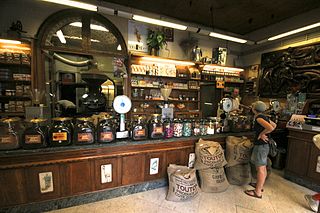
Italians are well known for their special attention to the preparation, the selection of the blends, and the use of accessories when creating many types of coffees. Many of the types of coffee preparation known today also have their roots here. The main coffee port in Italy is Trieste where there is also a lot of coffee processing industry. Italian coffee consumption, often espresso, is highest in the city of Trieste, with an average of 1500 cups of coffee per person per year. That is about twice as much as is usually drunk in Italy.

A barista is a person, usually a coffeehouse employee, who prepares and serves espresso-based coffee drinks and other beverages.

Caffè latte, often shortened to just latte in English, is a coffee drink of Italian origin made with espresso and steamed milk, traditionally served in a glass. Variants include the chocolate-flavored mocha or replacing the coffee with another beverage base such as masala chai, mate, matcha, turmeric or rooibos; alternatives to milk, such as soy milk, coconut milk, almond milk or oat milk, are also used.

An espresso machine brews coffee by forcing pressurized water near boiling point through a "puck" of ground coffee and a filter in order to produce a thick, concentrated coffee called espresso. Multiple machine designs have been created to produce espresso. Several machines share some common elements, such as a grouphead and a portafilter. An espresso machine may also have a steam wand which is used to steam and froth liquids for coffee drinks such as cappuccino and caffè latte.
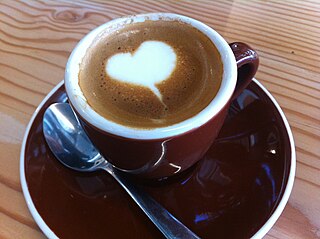
Caffè macchiato, sometimes called espresso macchiato and often shortened to just macchiato in English, is an espresso coffee drink with a small amount of milk, usually foamed. In Italian, macchiato means 'stained' or 'spotted', so the literal translation of caffè macchiato is 'stained coffee' or 'marked coffee'.

Café au lait is coffee with hot milk added. It differs from white coffee, which is coffee with cold milk or other whiteners added.
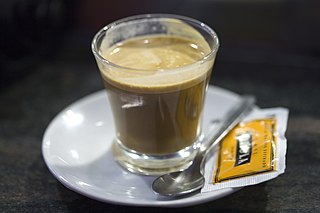
A cortado is a Spanish beverage consisting of espresso mixed with a roughly equal amount of warm milk to reduce the acidity, although the exact ratios have considerable regional variation. The milk in a cortado is steamed, but not frothy and "texturized" as in many Italian coffee drinks. The cortado is commonly served all over Spain. The word cortado is the past participle of the Spanish verb cortar, in the sense of "dilute", and can refer variously to either coffee or espresso drinks throughout Spanish and Portuguese speaking countries.

Latte macchiato is a coffee beverage. The name is Italian for 'stained milk', referring to the way the drink is prepared, by pouring a shot of espresso into steamed milk. It is a play on espresso macchiato, an older drink consisting of espresso marked with a dollop or two of milk or cream.

A flat white is a coffee drink consisting of espresso and steamed milk. It generally has a higher proportion of espresso to milk than a caffè latte, and lacks the thick layer of foam in a cappuccino. While the origin of the flat white is unclear, various café owners in Australia and New Zealand claim its invention.

Microfoam is finely textured milk used for making espresso-based coffee drinks, particularly those with latte art. It is typically made with the steam wand of an espresso machine, which pumps steam into a pitcher of milk.
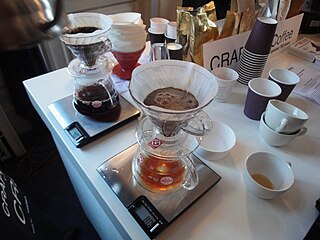
Coffee preparation is the process of turning coffee beans into liquid coffee. While the particular steps vary with the type of coffee and with the raw materials, the process includes four basic steps: raw coffee beans must be roasted, the roasted coffee beans must then be ground, and the ground coffee must then be mixed with hot or cold water for a specific time (brewed), the liquid coffee extraction must be separated from the used grounds, and finally, if desired, the extracted coffee is combined with other elements of the desired beverage, such as sweeteners, dairy products, dairy alternatives, or toppings.

Milk coffee is a category of coffee-based drinks made with milk. Johan Nieuhof, the Dutch ambassador to China, is credited as the first person to drink coffee with milk when he experimented with it around 1660.

Caffè americano, also known as americano or American, is a type of coffee drink prepared by diluting an espresso shot with hot water at a 1:3 to 1:4 ratio, resulting in a drink that retains the complex flavors of espresso, but in a lighter way. Its strength varies with the number of shots of espresso and the amount of water added. The name is also spelled with varying capitalization and use of diacritics: e.g., "café americano".

Caffè Mediterraneum, often referred to as Caffè Med or simply the Med, was a café located on Telegraph Avenue in Berkeley, California, US, near the University of California, Berkeley. The Med was a landmark of Telegraph Avenue history, "listed for years in European guidebooks as 'the gathering place for 1960s radicals who created People's Park'" and as of 2009 described in Fodor's guidebook as "a relic of 1960s-era café culture". It was located at 2475 Telegraph Avenue, between Dwight Way and Haste Street.
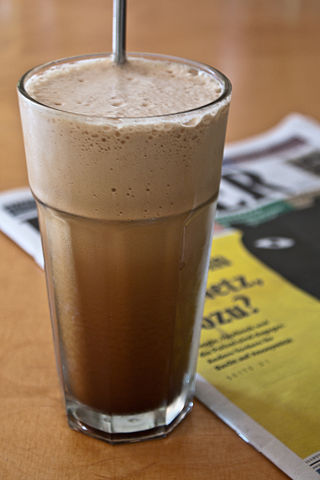
A frappé coffee, cold coffee, Greek frappé, or just frappé is a Greek iced coffee drink generally made from spray-dried instant coffee, water, sugar, and milk. The word is often written frappe. The frappé was invented in 1957 in Thessaloniki through experimentation by Dimitris Vakondios, a Nescafe representative. Frappés are among the most popular forms of coffee in Greece and Cyprus and have become a hallmark of postwar outdoor Greek coffee culture.
Caffè crema refers to two different coffee drinks:

A milk frother is a utensil for making milk froth, typically to be added to coffee. It aerates the milk, creating a thick but light foam. Milk frothers were introduced through the use of espresso machines that contained steamed wands that would froth steamed milk. Although created in Italy, the espresso machine and steam wands were exported internationally to other countries, and frothed milk was introduced around the world.




















